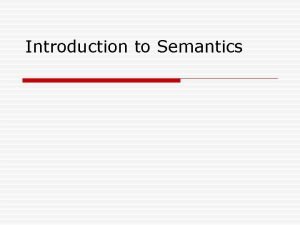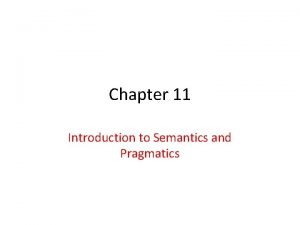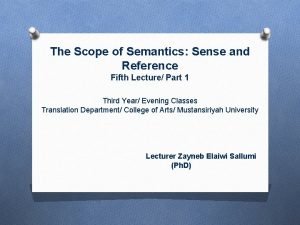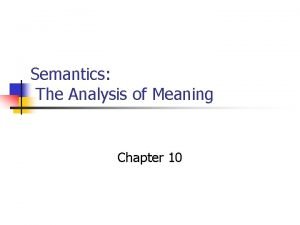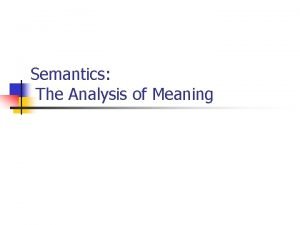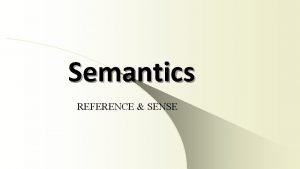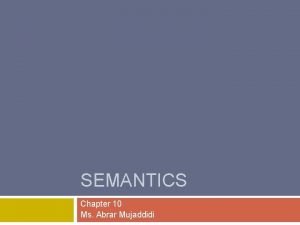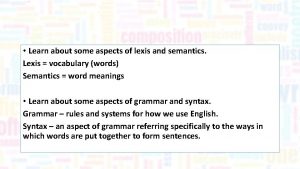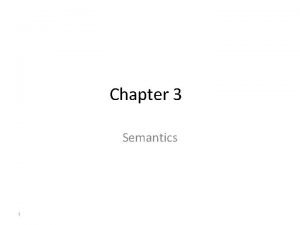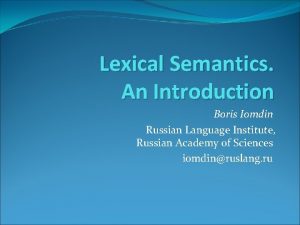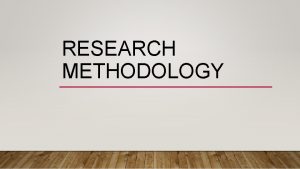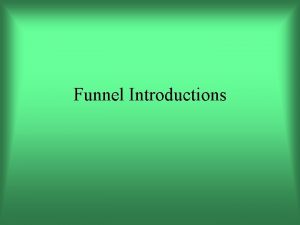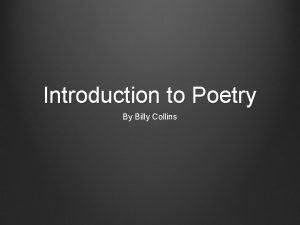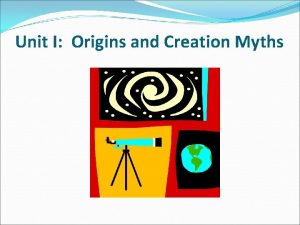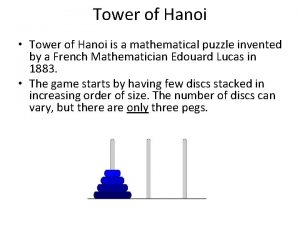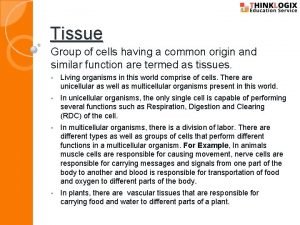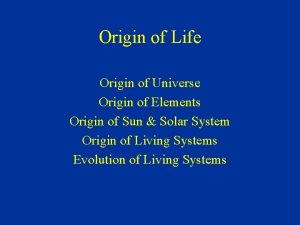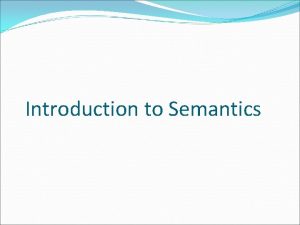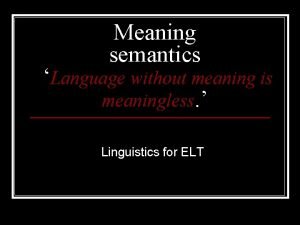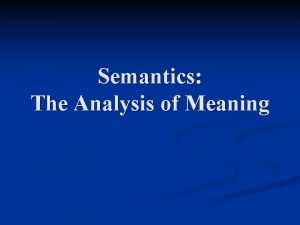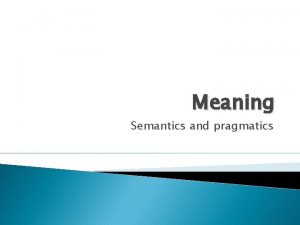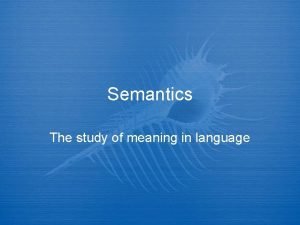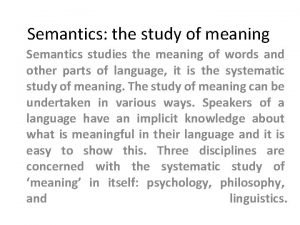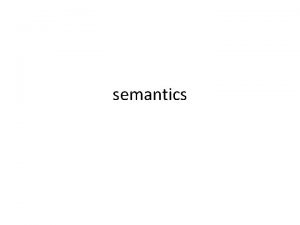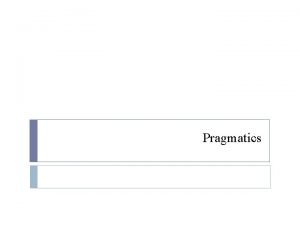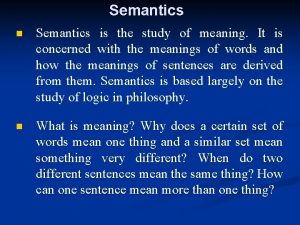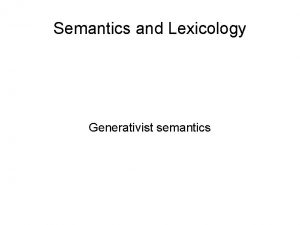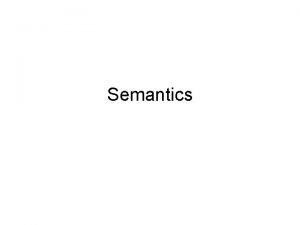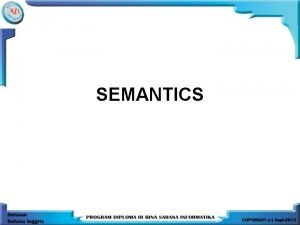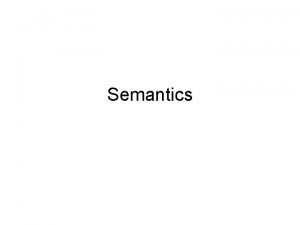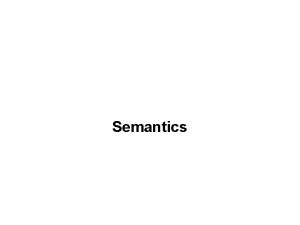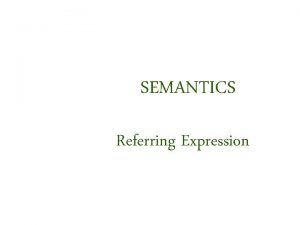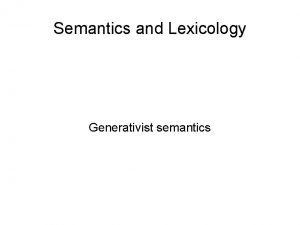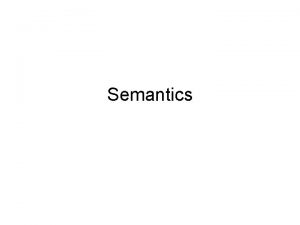SEMANTICS AN Introduction SEMANTICS MEANING ORIGIN SEMANTICS is





























- Slides: 29

SEMANTICS AN Introduction

SEMANTICS MEANING & ORIGIN SEMANTICS is the technical term used to refer to the study or science of meaning. It’s derived from the Greek word “sema” which means “sign”. It was used in: the 17 th century: “Semantick philosophy” to mean ‘divination’. 1893 when M. Breal coined the French term “semantique” from Greek. 1894 when “semantics” was first introduced to the American Philosophical Association in a paper entitled: “Reflected meanings: a point in semantics”. 1897 when Breal’s book was released and translated on 1900 into “Semantics: studies in the science of meaning”. The books treated semantics as the science of meaning and not as being concerned with the historical change of meaning, “historical semantics”, as it was used before.

THE USE OF THE TERMS “SEMANTICS” AND “SEMANTIC” The terms “semantics” and “semantic” are used in popular language especially in newspapers and bear only a slight resemblance to our use. They refer to the manipulation of language mostly to mislead. The following headlines from The Guardian in 1971 demonstrate this fact: - Semantic manoevres at the Pentagon = retreat - Homelessness reduced to semantics = the authority uses a narrow definition of homelessness to suggest that the number of homeless was considerably reduced.

SEMANTICS & LINGUISTICS SEMANTICS is a component or level of linguistics, the scientific study of language, of the same kind as phonetics or grammar.

SEMANTICS & SEMIOTICS Language is viewed as a communication system. The basic task of semantics is to show people communicate meanings with pieces of language. - Those vultures mean there’s a dead animal up ahead. - His high temperature means he has fever. - The red flag means it’s dangerous to swim here. Words are examples of verbal symbols and language represents man’s most sophisticated use of signs. The study of the linguistic meaning is a part of the general study of the use of sign systems “semiotics”. SEMIOTICS: investigates the types of relationship that may hold between a sign and the object or message it represents, or in de Saussure’s terminology, between a SIGNIFIER and its SIGNIFIED. C. S. Peirce makes a distinction between icon, index and symbol.

1 - Icon: similarity (a portrait and its real-life object)

2 - Index: causal relation (smoke is an index of fire)

3 - Symbol: conventional link (black clothes symbolize mourning)

MEANING The dictionary suggests a number of different meanings of “meaning” or the verb “mean”. Some meanings bear close resemblance others don’t: I mean to be there tomorrow. (intend) I don’t understand what you mean. (refer to) This job means a lot to me. (is important) You are meant to come to work at 9 o’clock. (are supposed) Don’t be too hard on him. He means well. (is well-intentioned) He said he loves me but I don’t think he meant it. (is serious or sincere)

MEANING, SIGNS AND SAMENESS “MEAN” can be used of signs: 1 - Natural signs: Those clouds mean thunder. 2 - Conventional signs: A red light means ‘stop’. When “mean” is most relevant to our purposes, we provide definitions by suggesting words or phrases that have the same meaning: - What does ‘calligraphy’ mean? - ‘Calligraphy’ is beautiful handwriting. It also applies to foreign languages: - What does ‘chat’ mean in French. - ‘Chat’ in French means ‘cat’.

PURPOSE OF STATING MEANING In stating meaning we are obliged to produce a term that is more familiar than the one whose meaning is being questioned. We translate from obscure terms, technical terms, or a foreign language into words that can be easily understood.

Literal & non-literal meaning - It wasn’t what he said, but what he meant. There are other meaning beside the literal meaning of words. There are different ways of achieving that: 1 - Prosodic features: intonation, stress, …etc. Fall-rise intonation may express: a) Reservation: She is very clever. (may imply that she is not honest or attractive) b) Uncertainty/ Confidence: I think so. (I don’t really know/ I’m sure) c) Sarcasm: That is very clever. (It is very stupid) 2 - Non-linguistic/ Paralinguistic features: wink, laugh, gestures, facial expressions, body language, . . . etc. - That is very clever. + wink = Sarcasm - That book is mine + laugh = The person is lying 3 - Presupposition: When did you stop beating your child. (It presupposes that he has beaten his child before without actually saying it)

NON-LITERAL OR FIGURATIVE USE Literal use: speakers speak in a neutral, factually accurate way. - I’m hungry. Non-literal (figurative) use: speakers deliberately describe something in untrue or impossible terms in order to achieve special effects. - I’m starving. - I could eat a horse. - My stomach thinks my throat is cut. It’s difficult to draw a clear-cut distinction between literal and nonliteral use of language because speakers tend to shift meaning of words to fit new conditions: METAPHORICAL EXTENSION: new ideas are depicted in in terms of something more familiar (computer mouse). After a while such expressions become fossilized.

CLUSTERINGS OF METAPHORICAL USES: Clusters of metaphorical uses are labeled such as “Time is money” to explain them (examples of dead metaphors which fade over time and become part of normal literal language): you’re wasting my time. This gadget will save you hours. I don’t have the time to give you. How do you spend your time? That flat tire cost me an hour. I’ve invested so much time in her. LITERAL LANGUAGE THEORY: a distinction between literal and nonliteral/ figurative uses of language is that the latter requires a different processing strategy than the former. - Go bananas. - Something is fishy! - Those hot dogs are really barking!

SEMANTICS & PRAGMATICS Both are related and complementary as they are both concerned with the transmission of meaning through language. An early use of the term pragmatics in Charles Morris’s division of semiotics (the study of signs): -Syntax: The formal relation of signs to each other. -Semantics: The relations of signs to the objects to which the signs are applicable. -Pragmatics: The relation of signs to interpreters. In terms of linguistic signs, PRAGMATICS is the study of the speaker/ hearer’s interpretation of language. Meaning described in relation to speakers & hearers = pragmatics Meaning abstracted away from users = semantics

SEMANTICS & PRAGMATICS THE PLACE IS CLOSING. (statement, warning, invitation, command, …etc. ). Sentence meaning: independent of any particular use. (Semantics) Speaker meaning: incorporated by a speaker into the particular meaning he/ she want to convey at a particular time. (Pragmatics) Is he awake? Pragmatics role is to investigate the interaction between purely linguistic knowledge and general or encyclopaedic knowledge.

SPOKEN LANGUAGE Spoken language is more basic than written language. Spoken language has striking characteristics that cannot be easily shown in written form: prosodic (intonation, stress, …etc. ) and paralinguistic features (wink, smile, …etc. ). Spoken language has been misleadingly described in terms appropriate to written language assuming that meaning is largely concerned with information while the main function of spoken language is not to inform but to carry out some other functions (establish social relations, …).

HUMAN LANGUAGE DIFFERES FROM OTHER COMMUNICATION SYSTEMS First, language does not always have a 'message’. language is not simply a matter of providing factual information and part of its function is concerned with social relationships. Secondly, in language both the sign ‘signifier’ and the message ‘signified’ are enormously complex and the relation between them is of even greater complexity. Thirdly, in language it is extremely difficult or even impossible to specify precisely what the message is. Words are difficult to be exactly defined but signs, like the red in traffic lights, can be easily identified in terms of language: “Red means stop”

LINGUISTICS IS SCIENTIFIC Linguistics is the scientific study of language. One essential requirement is that it should be empirical. Scientific = to be verifiable by observation. As part of linguistics, semantics should also be scientific. It can be easily seen in phonetics but it’s unfortunately not that simple in semantics.


LINGUISTICS IS SCIENTIFIC Chomsky made a distinction between Competence and performance. De Saussure made a distinction between Language (langue) and speaking (parole). Both excluded what is individual and incidental and insisted that the proper study of linguistics is language or competence. Chomsky’s competence and de Saussure’s language are idealized systems without any clear empirical basis. Palmer prefers to think that if linguistics is scientific, it must be concerned not with specific instances, but with generalisations.

UTTERANCE, SENTENCE AND PROPOSITION An utterance is the most concrete of them. It’s an event in time produced by a particular person at a particular point in time. It is related to speaking (parole) or performance. A sentence is an abstract entity that has no existence in time but is part of the linguistic system of language. It’s an abstract grammatical element obtained from utterances. It’s related to language (langue) or competence. Semantics will not be (and cannot really ever be) concerned with the meaning of utterances, but only with the meaning of sentences. A proposition is the description of states of affairs. It’s more abstract than sentences because the same proposition can be represented by different sentences: statements, questions, commands, …etc.

PROPOSITIONS These are different English sentences, but they convey the same message (express the same proposition). Richard wrote the report. Richard is the one who wrote the report. The report was written by Richard. The report is what Richard wrote. Different sentences allow the speaker to do different things with the same proposition as they share a propositional element: (Joan make the sorbet) Statement: Joan made the sorbet. Question: Did Joan make the sorbet? Command: Joan, make the sorbet!

SEMANTICS IN OTHER DISCIPLINES 1 - A philosophical approach to meaning. 2 - A Psychological approach to meaning.

1 - A PHILOSOPHICAL APPROACH TO SEMANTICS There is an overlap between the philosophical and the linguistic approach to meaning. Yet there has been certain areas od divergence: 1 - Logicians’ proposals to the study of meaning are not based upon observable language but on idealized systems and are self-coherent. There is little evidence of the possible application of logical systems to language. 2 - A distinction is made between science and the philosophy of science. The scientist explains the objects of his study by producing scientific rules for them. The philosopher explains how the scientific explanations can themselves be understood by explaining the nature of the scientific theory. The distinction between science and philosophy of science is less easy to make in linguistics because facts are so intangible, especially in the area of semantics.

2 - A PSYCHOLOGICAL APPROACH TO SEMANTICS Psychologists have tackled semantics in several ways: 1 - The approach found in Morris’s book “Sign, language and behavior” which is concerned with signs and what they denote or signify (behaviorist approach). (dog and buzzer) 2 - The approach found in Osgood et al’s book “The measurement of meaning” which measures the meaning of a word in terms of semantic space which is defined in terms of a twenty-questions-like quiz. It tells little about meaning in general but may something about emotive or connotational meaning (politician, statesman). The linguists is more interested in actual everyday speech than artificial conditions of psychological experiments. 3 -The communication theory in which familiar concepts are defined technically. The communication system carries INFORMATION and the system is judged according to the efficiency with which it transmits it. An efficient system will have (minimum redundancy) and (minimum noise). Semantics is concerned with the information rather than the transmission system.

CHALLENGES IN DOING SEMANTICS Analyzing a speaker’s semantic knowledge is a challenging task. Three challenges are faced when dealing with theory of semantics “THE DEFINITION THEORY”: 1 -Circularity: (ferret) = domesticated albino variety of the polecat, Mustela Putorius, bred for hunting rabbits, rats, etc. (Domesticated) = of animals, tame, living with human beings. (tame) = …. . 2 - How to make sure that our definitions of a word’s meaning are exact? Can we make a distinction between linguistic knowledge (meaning of words) and encyclopaedic knowledge (the way the world is)? (whale = mammal / fish) 3 - the contribution of context to meaning and how to include it in our definition since possibilities are enormous if not infinite: - Marvelous weather you have here in Ireland! - He’s dying!

MEETING THE CHALLENGES 1 - Circularity: Designing a semantic metalanguage (tool of description) to describe the semantic units and rules of all languages. In describing Arabic grammar in French, Arabic is the object language and French is the metalanguage. The ideal metalanguage would be neutral and should satisfy scientific criteria of clarity, economy, consistency, etc. 2 - Metalanguage also helps with the problem of relating semantic knowledge and encyclopaedic knowledge, since it includes arguing about the amount of knowledge that should be included. 3 - In tackling the problem of context, a traditional solution is to assume a split between the local contextual effects and a context -free element of meaning (conventional/ literal meaning).

REFERENCES Palmer, F. R. (1992) Semantics. Cambridge: MIT Press. Saeed, J. (2003) Semantics. Oxford: Blackwell.
 Compare procedural semantics and declarative semantics.
Compare procedural semantics and declarative semantics. Conceptual semantics
Conceptual semantics Introduction to semantics
Introduction to semantics Sense of scope
Sense of scope What is semantics features
What is semantics features Sentential semantics
Sentential semantics Semantic roles adalah
Semantic roles adalah Social neutral meaning
Social neutral meaning Lexical and grammatical meaning in semantics
Lexical and grammatical meaning in semantics Meaning of semantics
Meaning of semantics Communicative translation and semantic translation
Communicative translation and semantic translation Conceptual meaning in semantics
Conceptual meaning in semantics Lexis and semantics examples
Lexis and semantics examples Descriptive meaning in semantics
Descriptive meaning in semantics Types of semantics
Types of semantics Conceptual and associative meaning in semantics
Conceptual and associative meaning in semantics Essay structure
Essay structure Introduction meaning in research
Introduction meaning in research How to write a funnel introduction
How to write a funnel introduction Waterski across the surface of a poem
Waterski across the surface of a poem Origin of taoism
Origin of taoism The witches of easter-wick in finland
The witches of easter-wick in finland Same origin policy example
Same origin policy example Vestibulospinal tract origin
Vestibulospinal tract origin Kinocilium
Kinocilium Vestibular paroxysmia
Vestibular paroxysmia Origin myths definition
Origin myths definition Tower of hanoi origin
Tower of hanoi origin Certificate of origin
Certificate of origin Tissue is a group of cells having
Tissue is a group of cells having

